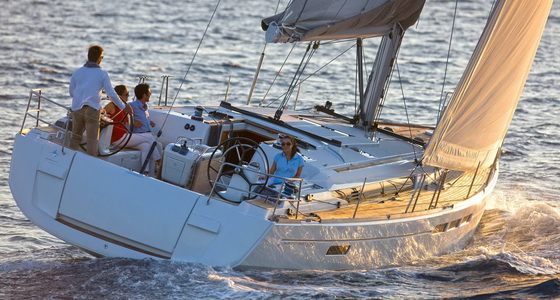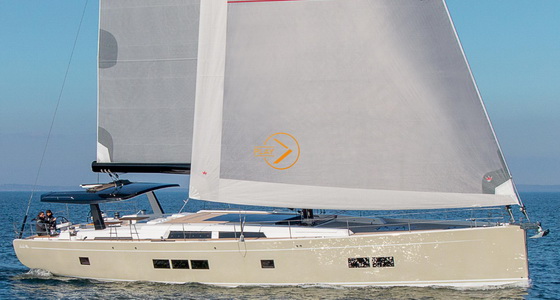Gross and net tonnage of a vessel are data about its volume. They are important for calculating various vessel fees, for the validity of licenses to operate vessels, maritime safety regulations, and in some other cases. It is especially important for boaters who have passed the Boat Leader exam in Slovenia, which allows them to operate a vessel – a yacht (a vessel longer than 12 m that can carry up to 12 passengers) flying the Croatian flag, with the restriction that the gross tonnage of the vessel does not exceed 30 GT (more in the article: Which boat licenses allow navigation in the Adriatic).
Until 1982, the unit RT or register ton (gross register ton and net register ton) was used to measure gross or net tonnage. One register ton equals 100 cubic feet or 2.832 m³. After 1994, an international agreement standardized the tonnage measurement system. It is now measured in cubic meters, and the unit is not written or used. Gross or net tonnage is expressed as a number without a unit, for example: GT = 30, which means the vessel has a gross tonnage of 30, but the volume of the vessel is not equal to 30 m³ and must be calculated using a formula.
Gross and net tonnage
Tonnage (gross or net) refers to the volume of enclosed spaces on the vessel and has no connection with the vessel’s weight. Gross tonnage of a vessel represents the total volume of enclosed parts of the vessel. Net tonnage refers to the volume of all enclosed spaces intended for passengers or cargo transport. Gross tonnage is denoted by the symbols GT, G.T., gt, BT, while net tonnage is denoted by NT, N.T., nt. The net tonnage of a vessel should not be less than 30% of the gross tonnage.
How to calculate tonnage
The calculation of the gross tonnage of a vessel is defined by rule 3 of Annex 1 of the International Convention on Tonnage Measurement of Ships, adopted in 1969. It depends on two parameters, V – the volume of the vessel and K – a coefficient that depends on the volume of the vessel. The coefficient K varies depending on the size of the vessel. It is smaller for smaller vessels and larger for larger vessels. It is calculated using the formula: K = 0.2 + 0.02 x log10(V). Once K is known, the gross tonnage of the vessel is calculated using the formula GT = V x K or GT = V x (0.2 + 0.02 x log10(V)). As we can see from the formula, gross tonnage contains the unit m³ and the logarithm of the same unit. Therefore, the unit is not used, and the term gross tonnage is primarily retained due to its historical significance.
Calculation of gross tonnage for vessels registered in Croatia
The calculation of gross tonnage for vessels in Croatia follows the international convention but has its specifics due to the definition of vessels based on their length. If we focus on those used for regular private cruising, recreation, and entertainment, these are:
- “Brodica” – vessels with a length of 2.5 m to 12 m or vessels with an engine power of more than 5 kW
- “Yacht” – a vessel for sports and leisure longer than 12 m and capable of carrying up to 12 passengers
Calculation for “brodice” vessels up to 12.00 m in length
The gross tonnage of vessels up to 12 m in length is calculated using the formula GT = 0.225 * V. V represents the total volume of the vessel in m³, which is calculated using the formula V = 0.55 * L * B * D + Σ l*b*h, where:
- L – length of the vessel in meters
- B – width of the vessel in meters
- H – height of the vessel in meters
- Σ l*b*h – sum of the volume of all spaces above the deck (l,b,h – average length, width, and height of each space expressed in meters)
*The gross tonnage of vessels smaller than 12 m has not been calculated or recorded in vessel documents in Croatia for the past few years.
Calculation of gross tonnage for yachts up to 24.00 m in length
The tonnage of a yacht is equal to its gross tonnage and is calculated using the formula GT = K * V. K is the coefficient, calculated by the formula K= 0.2 + 0.02 x log10(V). The volume is calculated using the formula V= Vh + Σ l*b*h, where:
- Vh = Kh * L * B * D – volume of the vessel below the deck expressed in m³
- Kh = 0.5 for sailing yachts, = 0.67 for motor vessels
- L – length of the hull
- B – width of the hull
- D – height of the hull
- Σ l*b*h – sum of the volume of all spaces above the deck (l,b,h – average length, width, and height of each space expressed in meters)
Calculation of gross tonnage for yachts over 24.00 m in length
GT = V x K where K= 0.2 + 0.02 x log10(V) or GT = V x (0.2 + 0.02 x log10(V)).
The coefficient K can be calculated using the formula or approximated from the table below.
Example calculation for the vessel Jeanneau Sun Odyssey 519
The Jeanneau Sun Odyssey 519 is one of the larger yachts in charter fleets. It measures 51.8 feet or 15.75 meters in length. To calculate gross tonnage, we use the formula for yachts up to 24 meters: GT = K * V where V = Kh * L * B * D.
- L – vessel length: 15.75 m
- B – vessel width: 4.69 m
- D – hull height: 2.5 m
- Kh (for sailing yacht): 0.5
V = 0.5 * 15.75 m * 4.69 m * 2.5 m = 92.33 m3
K = 0.2 + 0.02 * log10(92.33) = 0.2393
The calculated coefficient K is 0.2393. If we approximate for 90 m3 from the table, it would be 0.2391, which is a good approximation with a difference of only 0.0002 or 0.07%.
GT = K * V = 0.2393 * 92.33 = 22.09
CONCLUSION: According to Croatian law, with a Boat Leader license obtained in Slovenia, you are allowed to operate the Jeanneau Sun Odyssey 519 yacht sailing under the Croatian flag.
Example calculation for the vessel Hanse 675
To calculate gross tonnage, we use the formula for yachts up to 24 meters: GT = K * V where V = Kh * L * B * D.
- L – vessel length: 20.5 m
- B – vessel width: 5.9 m
- D – hull height: 2.5 m
- Kh (for sailing yacht): 0.5
V = 0.5 * 20.5 m * 5.9 m * 2.5 m = 151.18 m³
K = 0.2 + 0.02 * log10(151.18) = 0.2435
The calculated coefficient K is 0.2435. If we approximate for 150 m³ from the table, the value would be 0.2430, which is a good approximation with a difference of only 0.0005 or 0.2%.
GT = K * V = 0.2435 * 151.18 = 36.81
CONCLUSION: According to Croatian law, with a Boat Leader license obtained in Slovenia, you CANNOT operate the Hanse 675 yacht sailing under the Croatian flag. You need a “Seafarer Motorist” license, which allows operation of vessels up to 100 GT.
Read also: Which boat licenses allow navigation in the Adriatic
Table of coefficient K
| V (m3) | K | V (m3) | K | V (m3) | K | V (m3) | K |
| 10 | 0.2200 | 45.000 | 0.2931 | 330.000 | 0.3104 | 670.000 | 0.3165 |
| 20 | 0.2260 | 50.000 | 0.2940 | 340.000 | 0.3106 | 680.000 | 0.3165 |
| 30 | 0.2295 | 55.000 | 0.2948 | 350.000 | 0.3109 | 690.000 | 0.3168 |
| 40 | 0.2320 | 60.000 | 0.2956 | 360.000 | 0.3111 | 700.000 | 0.3169 |
| 50 | 0.2340 | 65.000 | 0.2963 | 370.000 | 0.3114 | 710.000 | 0.3170 |
| 60 | 0.2356 | 70.000 | 0.2969 | 380.000 | 0.3116 | 720.000 | 0.3171 |
| 70 | 0.2369 | 75.000 | 0.2975 | 390.000 | 0.3118 | 730.000 | 0.3173 |
| 80 | 0.2381 | 80.000 | 0.2981 | 400.000 | 0.3120 | 740.000 | 0.3174 |
| 90 | 0.2391 | 85.000 | 0.2986 | 410.000 | 0.3123 | 750.000 | 0.3175 |
| 100 | 0.2400 | 90.000 | 0.2991 | 420.000 | 0.3125 | 760.000 | 0.3176 |
| 200 | 0.2460 | 95.000 | 0.2996 | 430.000 | 0.3127 | 770.000 | 0.3177 |
| 300 | 0.2495 | 100.000 | 0.3000 | 440.000 | 0.3129 | 780.000 | 0.3178 |
| 400 | 0.2520 | 110.000 | 0.3008 | 450.000 | 0.3131 | 790.000 | 0.3180 |
| 500 | 0.2540 | 120.000 | 0.3016 | 460.000 | 0.3133 | 800.000 | 0.3181 |
| 600 | 0.2556 | 130.000 | 0.3023 | 470.000 | 0.3134 | 810.000 | 0.3182 |
| 700 | 0.2569 | 140.000 | 0.3029 | 480.000 | 0.3136 | 820.000 | 0.3183 |
| 800 | 0.2581 | 150.000 | 0.3035 | 490.000 | 0.3138 | 830.000 | 0.3184 |
| 900 | 0.2591 | 160.000 | 0.3041 | 500.000 | 0.3140 | 840.000 | 0.3185 |
| 1.000 | 0.2600 | 170.000 | 0.3046 | 510.000 | 0.3142 | 850.000 | 0.3186 |
| 2.000 | 0.2660 | 180.000 | 0.3051 | 520.000 | 0.3143 | 860.000 | 0.3187 |
| 3.000 | 0.2695 | 190.000 | 0.3056 | 530.000 | 0.3145 | 870.000 | 0.3188 |
| 4.000 | 0.2720 | 200.000 | 0.3060 | 540.000 | 0.3245 | 880.000 | 0.3189 |
| 5.000 | 0.2740 | 210.000 | 0.3064 | 550.000 | 0.3148 | 890.000 | 0.3190 |
| 6.000 | 0.2756 | 220.000 | 0.3068 | 560.000 | 0.3150 | 900.000 | 0.3191 |
| 7.000 | 0.2769 | 230.000 | 0.3072 | 570.000 | 0.3151 | 910.000 | 0.3192 |
| 8.000 | 0.2781 | 240.000 | 0.3076 | 580.000 | 0.3153 | 920.000 | 0.3193 |
| 9.000 | 0.2791 | 250.000 | 0.3080 | 590.000 | 0.3154 | 930.000 | 0.3194 |
| 10.000 | 0.2800 | 260.000 | 0.3083 | 600.000 | 0.3156 | 940.000 | 0.3195 |
| 15.000 | 0.2835 | 270.000 | 0.3086 | 610.000 | 0.3157 | 950.000 | 0.3196 |
| 20.000 | 0.2860 | 280.000 | 0.3089 | 620.000 | 0.3158 | 960.000 | 0.3196 |
| 25.000 | 0.2880 | 290.000 | 0.3092 | 630.000 | 0.3160 | 970.000 | 0.3197 |
| 30.000 | 0.2895 | 300.000 | 0.3095 | 640.000 | 0.3161 | 980.000 | 0.3198 |
| 35.000 | 0.2909 | 310.000 | 0.3098 | 650.000 | 0.3163 | 990.000 | 0.3199 |
| 40.000 | 0.2920 | 320.000 | 0.3001 | 660.000 | 0.3164 | 1.000.000 | 0.3200 |
Regulations for the Calibration of Maritime Objects (CRO, 2009), www.admiraltylawguide.com
Source: enavtika.si



